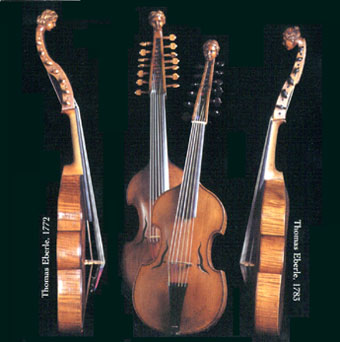![]()
![]()
![]()
![]()
Many Strings Attached - Eighteenth Century Music for Viola D'amore. Christian Pezold: Partita in F, for viola d'amore solo senza basso; J.S. Bach: Partita in a, BWV 1013 (arr. Thomas Georgi); Christian Pezold: Partita in A, for viola d'amore senza basso; "Serenade" from Neu method-messige Viol d'Amor Stuke. Thomas Georgi, viola d'amore. MSA 001 (63'41). For ordering information visit http://www.violadamore.com/order.asp
In his 1756 publication, A Treatise on the Fundamental Principles of Violin Playing, Leopold Mozart describes the viola d'amore thus:
It is a distinctive kind of fiddle which sounds especially charming in the stillness of the evening. Above, it is strung with six gut strings of which the lower three are covered, while below the fingerboard are stretched six steel strings, which are neither plucked nor bowed but are there merely to duplicate and prolong the sound of the upper strings.The ethereal, sustained quality that the sympathetic strings give to the viola d'amore produces a beautiful timbre often exploited by composers in the 17th and 18th centuries. Vivaldi, Telemann, and Bach wrote for the instrument, frequently using unusual tunings. Largely forgotten in the 19th century, in the 20th it was employed in Strauss's Symphonia domestica, Puccini's Madama Butterfly, and in several works of Hindemith, including a concerto (Op. 46, No. 1).

As anyone who has fooled around with the sustaining pedal on a piano will have discovered, an instrument such as the viola d'amore works best with music of a simple harmonic base. The music chosen for this disk reflects this and includes two suites by Christian Pezold (1677-1733), a composer best known for two minuettes anonymously included in the Notenbüchlein für Anna Magdalena Bach. The suites derive from a manuscript copy which contains only the viola d'amore part, although it is probable that they were originally scored for basso continuo accompaniment. Even so, they are satisfying works which serve the purpose of showing off the viola d'amore's sonorous charms. There is also a transcription of J. S. Bach's Partita in A minor (BWV 1013, originally for transverse flute) and collection of movements from Anton Huberty's Neu method-messige Viol d'Amor Stuke (1780). While Pezold's suites are more musically cohesive, the excerpts from Huberty give the listener a chance to hear various effects the instrument is capable of.
Thomas Georgi is a stylish player, obviously comfortable with his instrument. The recording is clear and reverberant, well suited for listening "in the stillness of the evening."